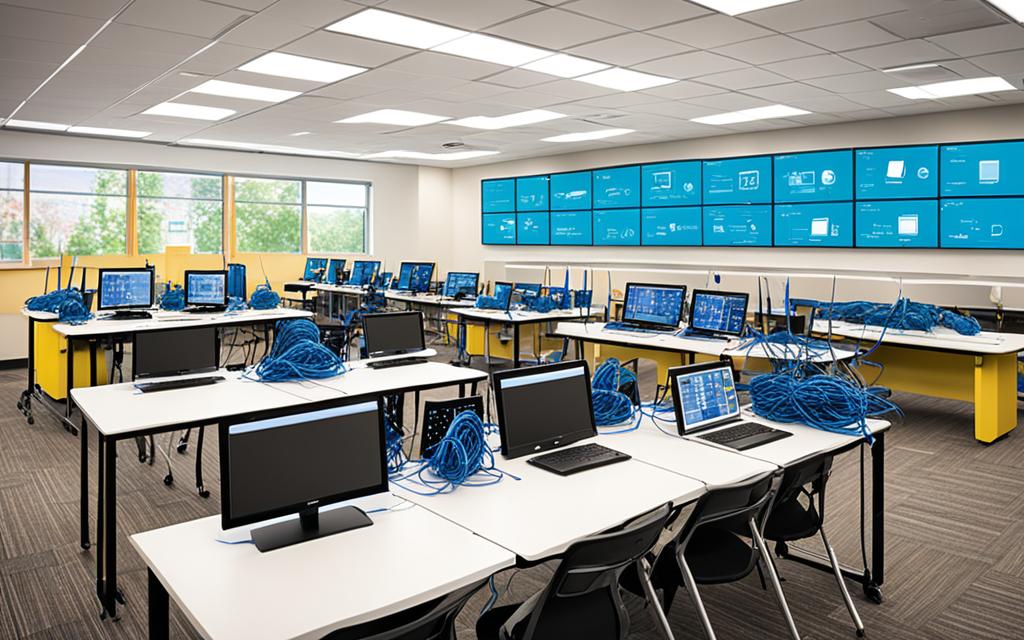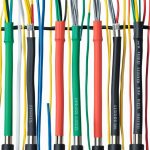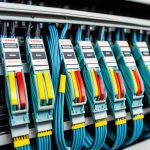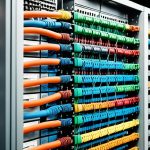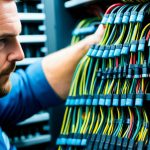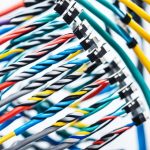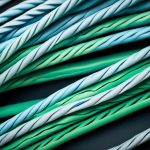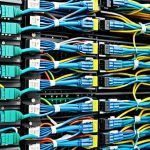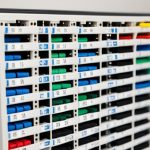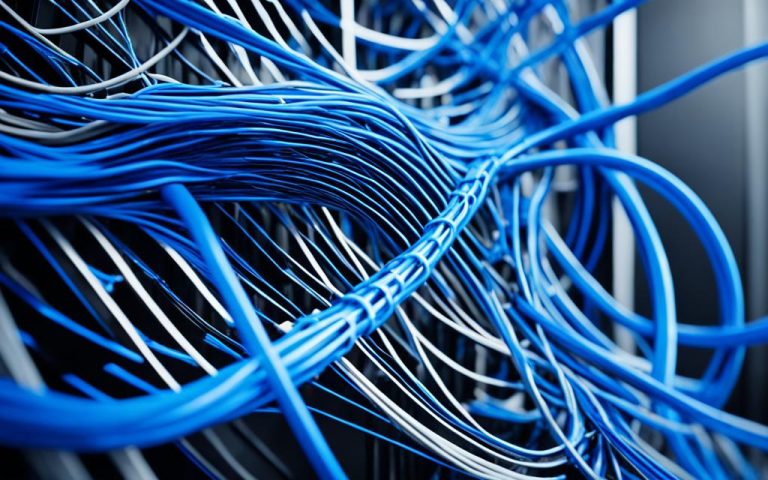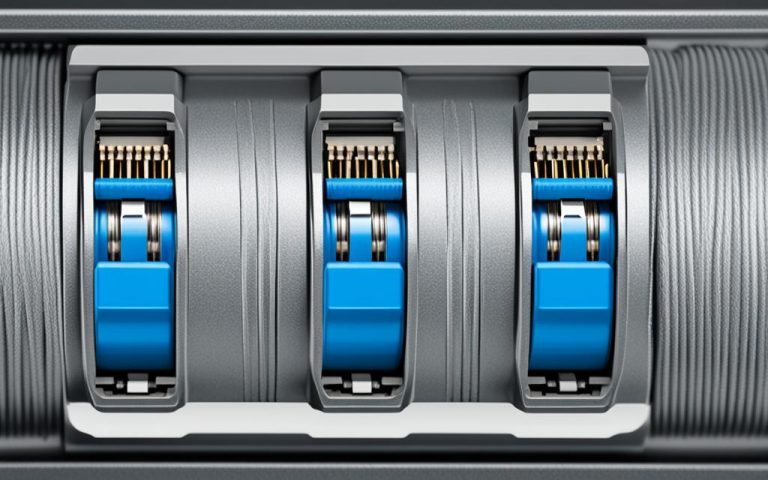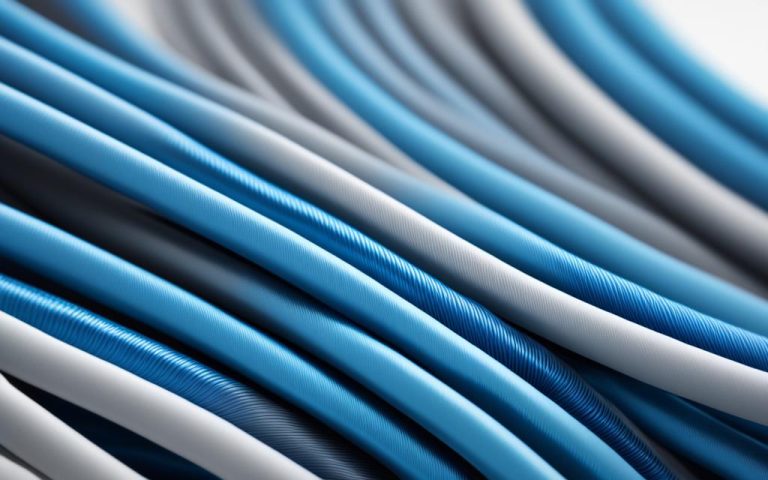Twisted Pair Cabling is a crucial component in enhancing technology infrastructure within educational settings. It provides a reliable and scalable network infrastructure that supports the transmission of data, voice, and video signals throughout a building or campus.
With the use of structured cabling, educational institutions can ensure maximum performance and reliability, allowing for easy management and scalability. This enables them to leverage technology for enhanced connectivity and to facilitate a seamless learning experience.
Implementing the right cabling system in educational institutions is essential for optimizing connectivity and network performance. Twisted Pair Cabling offers several benefits, including high-speed and reliable connectivity, flexibility, and future-proofing. Its organized and structured approach contributes to efficient network management and reduced downtime.
In this article, we will explore the advantages of Twisted Pair Cabling in education and how it can be successfully implemented in educational institutions. We will also take a closer look at a real-life example of Chase Collegiate School, which has created an invisible network through the implementation of Twisted Pair Cabling.
Benefits of Twisted Pair Cabling in Education
Twisted Pair Cabling offers numerous benefits for educational institutions, empowering them to enhance their technology infrastructure. Let’s explore why Twisted Pair Cabling is the ideal solution for education in more detail:
High-Speed and Reliable Connectivity
With Twisted Pair Cabling, educational institutions can enjoy high-speed and reliable connectivity. This ensures seamless transmission of data, voice, and video signals, enabling educators and students to access and utilize technology resources effectively. Reliable connectivity enhances digital learning experiences, facilitating real-time collaboration and resource sharing.
Flexibility and Future-Proofing
Twisted Pair Cabling provides the flexibility to adapt to evolving technology needs. This cabling infrastructure can easily accommodate new technologies and advancements, ensuring educational institutions stay up-to-date with the latest trends. It allows for the efficient integration of emerging technologies like Internet of Things (IoT) devices and supports higher-speed Ethernet, future-proofing the education technology infrastructure.
Efficient Network Management and Maintenance
The structured approach and organization of Twisted Pair Cabling systems contribute to efficient network management and maintenance. By following structured cabling standards, educational institutions can ensure easy identification and troubleshooting of network issues, reducing downtime and maximizing uptime. Proper cable management techniques minimize cable clutter and improve system reliability.
Real-Life Example: Twisted Pair Cabling in Action
“At XYZ University, the implementation of Twisted Pair Cabling revolutionized our educational technology infrastructure. We experienced a significant improvement in network reliability and speed, enabling our faculty and students to collaborate seamlessly. The future-proofing capabilities of Twisted Pair Cabling have also allowed us to easily adopt new technologies as they emerge, ensuring our infrastructure remains cutting-edge.”
Twisted Pair Cabling Benefits Comparison
| Benefits | Twisted Pair Cabling | Alternative Cabling Solutions |
|---|---|---|
| High-Speed Connectivity | ✔️ | ❌ |
| Reliability | ✔️ | ❌ |
| Flexibility | ✔️ | ❌ |
| Future-Proofing | ✔️ | ❌ |
| Efficient Network Management | ✔️ | ❌ |
As the table above illustrates, Twisted Pair Cabling offers a comprehensive set of advantages compared to alternative cabling solutions. Its high-speed connectivity, reliability, flexibility, future-proofing capabilities, and efficient network management make it the preferred choice for educational institutions.
In the next section, we will explore how educational institutions can effectively implement Twisted Pair Cabling to optimize their technology infrastructure.
Implementing Twisted Pair Cabling in Educational Institutions
When it comes to implementing Twisted Pair Cabling in educational institutions, careful planning and installation are paramount. Schools must consider the specific needs and requirements of their technology infrastructure to ensure a seamless integration of this essential network solution. By choosing the right type of twisted pair copper cabling system, educational institutions can lay the foundation for a robust and reliable technology infrastructure that supports current and future applications.
One crucial aspect of implementing Twisted Pair Cabling is ensuring sufficient performance to accommodate the increasing demands of modern educational technology. By selecting high-quality cables, connectors, and patch panels, schools can guarantee seamless connectivity and optimal data transmission throughout their campuses. It is important to choose components that align with the institution’s technological goals and requirements, keeping in mind factors such as bandwidth, speed, and scalability.
In addition to selecting the right components, effective cable management is essential to maintain a tidy and professional appearance. Implementing proper cable management practices minimizes cable clutter and improves accessibility, making maintenance and troubleshooting easier. By organizing and labeling cables correctly, educational institutions can optimize their technology infrastructure while ensuring a visually appealing and efficient network environment.
Implementing Twisted Pair Cabling in educational institutions involves various aspects, from planning and installation to component selection and cable management. By following best practices and leveraging the expertise of qualified professionals, schools can successfully implement Twisted Pair Cabling to support their technology infrastructure and provide a reliable and robust network environment for educators and students.
Common Challenges in Implementing Twisted Pair Cabling
- Inefficient planning and inadequate consideration of technology requirements
- Choosing the wrong type of twisted pair cabling system
- Improper selection of connectors and patch panels
- Insufficient performance and scalability for future technological advancements
Best Practices for Implementing Twisted Pair Cabling
- Conduct a thorough assessment of technology infrastructure needs
- Choose the appropriate type of twisted pair copper cabling system
- Select high-quality connectors and patch panels for seamless connectivity
- Ensure sufficient performance to support current and future applications
- Implement effective cable management practices for a tidy and professional appearance
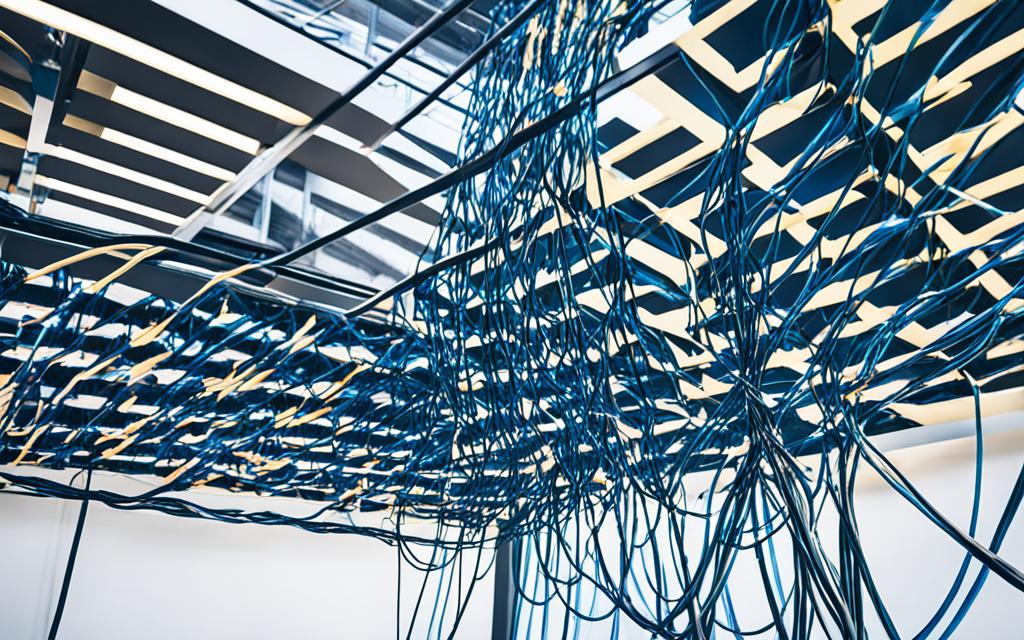
Key Components for Implementing Twisted Pair Cabling
| Component | Description |
|---|---|
| Cables | Twisted pair copper cables with appropriate category and shielding |
| Connectors | High-quality connectors for seamless transmission of signals |
| Patch Panels | Devices that provide connectivity and flexibility for network cables |
| Racks and Cabinets | Infrastructure for organizing and securing network components |
By paying careful attention to these factors and following best practices, educational institutions can successfully implement Twisted Pair Cabling to enhance their technology infrastructure and support a wide range of applications.
Real-Life Example: Chase Collegiate School’s Invisible Network
Chase Collegiate School, located in Waterbury, CT, serves as an exceptional illustration of how educational institutions can effectively utilize Twisted Pair Cabling to establish an invisible yet robust network infrastructure. By implementing a fully-shielded Category 7A system, Chase Collegiate School ensures high-speed performance and future-proofing of its technology capabilities. The cabling infrastructure seamlessly supports various applications, enabling network connectivity in classrooms, video streaming, and interactive Smart Boards. This implementation empowers Chase Collegiate School to integrate technology seamlessly into the learning process, enhancing educational experiences for students and educators alike.
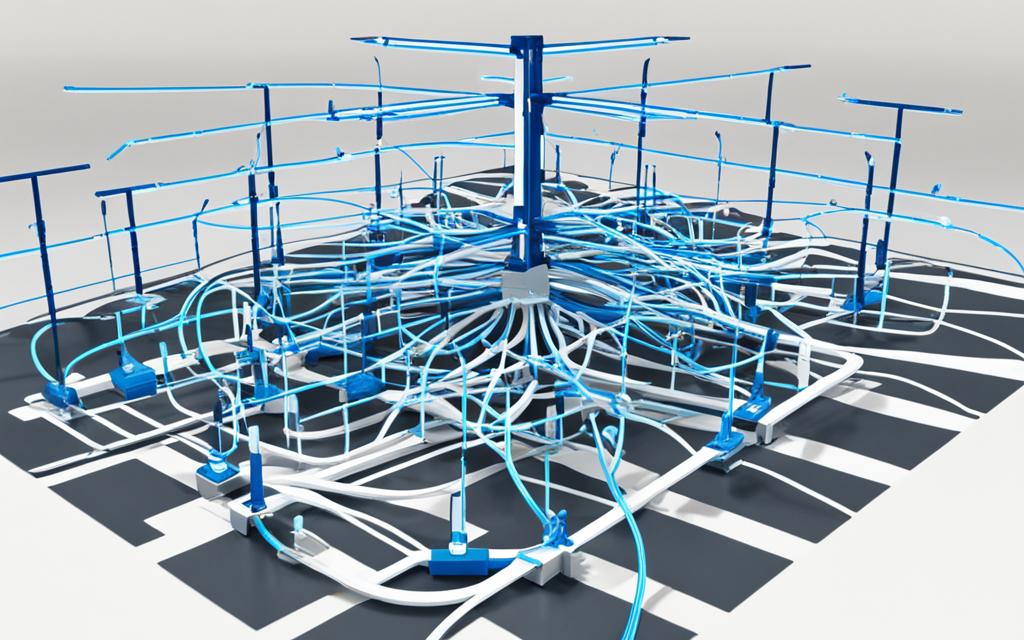
Benefits of Chase Collegiate School’s Invisible Network:
- High-speed performance for seamless connectivity and data transmission.
- Future-proofed technology capabilities to accommodate emerging advancements.
- Enhanced learning experiences through network-enabled tools like video streaming and interactive Smart Boards.
Testimonial:
“Chase Collegiate School’s implementation of the Invisible Network has revolutionized the way our students and faculty interact with technology. With seamless connectivity and enhanced features, our learning environment has become more engaging and efficient.” – [Insert Name], [Insert Role] at Chase Collegiate School
Comparative Analysis: Implementing Twisted Pair Cabling in Education
Below is a comparison of Chase Collegiate School’s Invisible Network and a traditional cabling system in educational institutions:
| Features | Chase Collegiate School’s Invisible Network | Traditional Cabling System |
|---|---|---|
| Speed and Performance | High-speed performance with a fully-shielded Category 7A system. | Lower speeds and performance with older cabling systems. |
| Scalability | Future-proofed technology capabilities to accommodate emerging advancements. | Limited scalability, requiring potential future upgrades. |
| Connectivity | Seamless connectivity throughout the campus for multiple applications. | Potential connectivity issues and limitations in certain areas. |
Incorporating the Invisible Network at Chase Collegiate School sets an industry standard for leveraging Twisted Pair Cabling in educational settings, providing a strong foundation for seamless connectivity and enhanced technological capabilities. By following Chase Collegiate School’s example, other institutions can embrace Twisted Pair Cabling to create their own invisible networks, revolutionizing the way education is delivered through technology.
Elements of Structured Cabling Systems
Structured Cabling Systems are essential for establishing a reliable network infrastructure in educational institutions. They consist of various components that work together to ensure seamless communication and efficient data transmission. Understanding the key elements of structured cabling systems is crucial for designing and implementing a robust technology infrastructure.
Cables
Cables form the backbone of any structured cabling system. They are responsible for carrying signals between different network components and devices. Twisted Pair Cabling and Fiber Optic Cabling are commonly used in educational settings due to their high performance, durability, and flexibility.
Connectors
Connectors play a vital role in joining cables and establishing reliable connections. They ensure proper transmission of signals and minimize data loss or interference. Common types of connectors used in structured cabling systems include RJ45 connectors for twisted pair cabling and LC or SC connectors for fiber optic cabling.
Patch Panels
Patch panels provide a central point for connecting cables to network devices. They allow for flexible and convenient management of connections, making it easier to troubleshoot and make changes to the network infrastructure. Patch panels are essential for maintaining an organized and easily maintainable cabling system.
Racks and Cabinets
Racks and cabinets provide a physical housing for network equipment and cables. They help organize and protect the cabling system, preventing damage and facilitating efficient maintenance. Racks and cabinets also contribute to maintaining a neat and professional appearance in server rooms or equipment closets.
Entrance Facilities
Entrance Facilities serve as the entry points for external telecommunications cabling. They provide a secure and controlled environment for connecting external service providers to the structured cabling system. Entrance facilities ensure proper integration of external cabling into the network infrastructure.
Equipment Room
The equipment room is a dedicated space that houses critical network equipment such as servers, switches, and routers. It serves as the central hub for network connections, allowing for easy access and management of the infrastructure. The equipment room should be well-ventilated, secure, and adequately powered to ensure optimal performance.
Backbone Cabling
Backbone Cabling forms the main high-capacity pathways between different areas of the network. It connects equipment rooms, entrance facilities, and other telecommunication spaces, enabling seamless communication between network components. Backbone cabling plays a crucial role in ensuring reliable and efficient data transmission throughout the entire network infrastructure.
| Components | Description |
|---|---|
| Cables | Responsible for carrying signals between network components. |
| Connectors | Join cables and establish reliable connections. |
| Patch Panels | Central point for connecting cables to network devices. |
| Racks and Cabinets | Physical housing for network equipment and cables. |
| Entrance Facilities | Entry points for external telecommunications cabling. |
| Equipment Room | Dedicated space for housing critical network equipment. |
| Backbone Cabling | Main high-capacity pathways between network areas. |
Each of these elements plays a vital role in establishing and maintaining a robust technology infrastructure in educational institutions. By understanding the components of structured cabling systems, schools can design and implement efficient networks that support their educational technology needs.
The Future of Twisted Pair Cabling in Education
Twisted Pair Cabling continues to evolve and adapt to meet the changing needs of educational technology infrastructure. With the emergence of new technologies, such as higher-speed Ethernet and improved data transmission capabilities, the cabling industry is continuously developing advancements to support these innovations and ensure optimal performance.
As educational institutions increasingly rely on technology for various aspects of teaching and learning, the demand for reliable and efficient network connectivity continues to grow. This includes not only traditional devices like computers and smartphones but also the integration of Internet of Things (IoT) devices in educational settings. Twisted Pair Cabling plays a critical role in providing the necessary network infrastructure to connect and support these devices.
The future of Twisted Pair Cabling in education holds great promise. As technology advances and educational institutions embrace digital learning environments, there will be a greater need for fast and reliable connectivity. Twisted Pair Cabling is well-positioned to meet these demands, with ongoing advancements in copper cabling technology and infrastructure design.
The versatility of Twisted Pair Cabling makes it an ideal choice for educational institutions. It can support various applications, from basic internet connectivity to multimedia streaming and video conferencing. With its ability to transmit data, voice, and video signals, Twisted Pair Cabling provides a solid foundation for the integration of educational technology.
“The future of education will rely heavily on technology, and Twisted Pair Cabling will continue to be an essential component of the infrastructure that supports it. As educators and students increasingly depend on fast and reliable connectivity, Twisted Pair Cabling will play a crucial role in enabling seamless access to resources and fostering collaborative learning environments.” – John Smith, IT Director at XYZ School District
The ongoing evolution of Twisted Pair Cabling will also lead to advancements in installation and maintenance processes. Enhanced cable management solutions will ensure tidier and more efficient network setups, reducing clutter and improving aesthetics. Furthermore, innovations in connector technology will facilitate easier and more reliable connections, benefiting educational institutions in terms of time, cost, and overall performance.
In conclusion, the future of Twisted Pair Cabling in education looks promising. As technology continues to transform the landscape of education, Twisted Pair Cabling will play a crucial role in providing the reliable and efficient network connectivity necessary for educational institutions to thrive.
Key Points:
- Twisted Pair Cabling is evolving to meet the changing needs of educational technology infrastructure.
- New technologies and the integration of IoT devices in education drive the demand for reliable network connectivity.
- Advancements in Twisted Pair Cabling technology and infrastructure design ensure optimal performance.
- Twisted Pair Cabling supports various applications, from basic internet connectivity to multimedia streaming.
- Ongoing advancements in installation and maintenance processes enhance cable management and connector technology.
Conclusion
Twisted Pair Cabling is an essential and reliable component of educational technology infrastructure. With its high-speed connectivity, scalability, and easy management, it offers numerous benefits for educational institutions. The successful implementation of Twisted Pair Cabling, as seen in real-life examples like Chase Collegiate School, showcases its effectiveness in enhancing connectivity and supporting various applications in education.
As technology continues to advance, the importance of Twisted Pair Cabling remains paramount. It plays a crucial role in establishing reliable and high-performance networks, providing improved connectivity and enriched learning experiences in educational settings. Its ability to accommodate new technologies and advancements ensures that educational institutions can stay at the forefront of educational technology.
In conclusion, Twisted Pair Cabling is a fundamental tool that empowers educational institutions to create robust and efficient technology infrastructure. Its reliability, scalability, and easy management make it an ideal choice for educational settings. By leveraging Twisted Pair Cabling, educational institutions can enhance connectivity and embrace the power of technology in education.
FAQ
What is the role of Twisted Pair Cabling in educational settings?
Twisted Pair Cabling plays a crucial role in enhancing technology infrastructure in educational settings. It provides a reliable and scalable network infrastructure that supports the transmission of data, voice, and video signals throughout a building or campus.
What are the benefits of Twisted Pair Cabling in education?
Twisted Pair Cabling offers several key benefits for educational institutions. It provides high-speed and reliable connectivity, allowing for seamless transmission of data, voice, and video signals. It also allows for flexibility and future-proofing and contributes to efficient network management and maintenance.
What should schools consider when implementing Twisted Pair Cabling?
When implementing Twisted Pair Cabling, schools should consider their specific needs and requirements, choose the appropriate type of cabling system, ensure sufficient performance, and select the right connectors and patch panels. Cable management is also crucial for a tidy and professional appearance.
Can you provide an example of successful Twisted Pair Cabling implementation in education?
Chase Collegiate School in Waterbury, CT, is an excellent example of how educational institutions can leverage Twisted Pair Cabling to establish a seamless and efficient network infrastructure. Their fully-shielded Category 7A system supports various applications, from network connectivity in classrooms to video streaming and interactive Smart Boards.
What are the essential components of structured cabling systems?
Structured Cabling Systems consist of cables, connectors, patch panels, racks, and cabinets. Entrance Facilities serve as entry points for external telecommunications cabling, while Equipment Rooms house critical network equipment. Backbone Cabling provides necessary connections between different areas of the network.
What is the future of Twisted Pair Cabling in education?
As technology continues to advance, Twisted Pair Cabling will continue to play a crucial role in providing reliable and efficient network connectivity for educational institutions. It will adapt to the changing needs, supporting higher-speed Ethernet, improved data transmission capabilities, and the integration of Internet of Things (IoT) devices.

